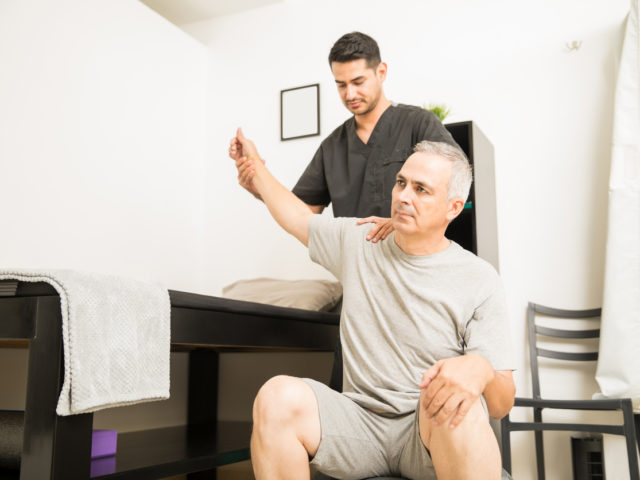As we age, maintaining our balance and preventing falls becomes increasingly important. Falls are a leading cause of injury and even death among older adults. According to the Centers for Disease Control and Prevention (CDC), one in four older adults falls each year in the United States. Falls can result in fractures, head injuries, and other serious consequences that can significantly impact the quality of life for seniors.
The good news is that falls are not an inevitable part of aging. Many falls can be prevented with the right strategies and interventions, and physical therapy plays a crucial role in fall prevention and improving balance in the elderly. In this blog post, we will explore the importance of balance and fall prevention for older adults and how physical therapy can be an effective tool for achieving these goals.
Why Balance Matters
Maintaining good balance is essential for overall mobility and independence. As we age, several factors can affect our balance, including changes in muscle strength, joint flexibility, and sensory perception. Here are some key reasons why balance is vital for older adults:
1. Preventing Falls:
- Good balance is the first line of defense against falls. When you have better balance, you are less likely to lose your footing and fall.
2. Maintaining Independence:
- Balance plays a crucial role in performing daily activities independently, such as walking, dressing, and even cooking.
3. Reducing the Risk of Injury:
- If a fall does occur, having a good balance can help reduce the severity of injuries, as you may be better able to protect yourself during the fall.
4. Enhancing Quality of Life:
- Improved balance means greater confidence and a higher quality of life, as you can continue to engage in activities you enjoy.
Common Causes of Balance Issues
Several factors contribute to balance problems in older adults, including:
1. Muscle Weakness:
- As we age, we tend to lose muscle mass and strength, which can affect our ability to maintain balance.
2. Joint Stiffness:
- Stiffness in the joints, particularly the ankles, knees, and hips, can limit range of motion and affect balance.
3. Medications:
- Some medications may have side effects that impact balance and coordination.
4. Vision Changes:
- Age-related vision changes can affect depth perception and spatial awareness.
5. Inner Ear Problems:
- Issues with the inner ear, which is responsible for balance, can lead to dizziness and vertigo.

How Physical Therapy Can Help
Physical therapy is a valuable resource for older adults seeking to improve their balance and prevent falls. Here’s how physical therapists can assist:
1. Comprehensive Assessment:
- Physical therapists conduct a thorough evaluation to assess a patient’s current balance, strength, flexibility, and gait.
2. Individualized Treatment Plan:
- Based on the assessment, physical therapists create personalized treatment plans tailored to the specific needs and goals of the patient.
3. Strength and Flexibility Exercises:
- Physical therapists prescribe exercises to strengthen muscles, particularly those in the legs and core, to improve balance and stability.
4. Gait Training:
- Gait training focuses on improving the way a person walks to reduce the risk of tripping or stumbling.
5. Balance Training:
- Balance exercises challenge and improve the body’s proprioception and coordination, enhancing balance.
6. Home Safety Assessment:
- Physical therapists can evaluate the patient’s home environment to identify potential hazards and suggest modifications.
7. Education:
- Patients receive education on fall prevention strategies, such as how to get up safely after a fall and how to use assistive devices if needed.
8. Assistive Devices:
- If necessary, physical therapists can recommend and teach patients how to use assistive devices like canes or walkers.
9. Medication Review:
- Physical therapists can collaborate with healthcare providers to review medications and address any that may be affecting balance.
The Importance of Staying Active
Physical activity is a cornerstone of fall prevention and balance improvement. Physical therapists emphasize the importance of staying active and engage patients in exercises that promote strength, flexibility, and balance. Staying active not only helps improve physical function but also boosts confidence and reduces the fear of falling.
Fall Prevention Tips for Older Adults
In addition to working with a physical therapist, there are several steps older adults can take to prevent falls and improve their balance:
1. Regular Exercise:
- Engage in regular physical activity to maintain muscle strength and balance. Tai Chi and yoga are particularly beneficial for balance.
2. Medication Management:
- Review medications with a healthcare provider to identify any that may increase the risk of falls or dizziness.
3. Regular Vision Checkups:
- Visit an eye doctor for regular checkups and update eyeglass prescriptions as needed.
4. Home Safety:
- Remove hazards like loose rugs or clutter that can lead to tripping. Install grab bars in bathrooms and ensure adequate lighting.
5. Footwear:
- Wear supportive, well-fitting shoes with nonslip soles.
6. Stay Hydrated:
- Dehydration can lead to dizziness, so be sure to drink enough water.
The Role of Technology
Advancements in technology have also contributed to fall prevention efforts. Wearable devices like fitness trackers and smartwatches can provide real-time data on steps taken, balance, and physical activity, encouraging users to stay active and monitor their progress. Additionally, some devices are equipped with fall detection and alert features, providing an extra layer of safety for older adults.
In Conclusion
Balance and fall prevention are critical components of healthy aging. Physical therapy offers a holistic and effective approach to improving balance, reducing the risk of falls, and enhancing the quality of life for older adults. By working with the best physical therapy services and incorporating lifestyle modifications, older adults can maintain their independence, stay active, and enjoy a higher quality of life as they age.
